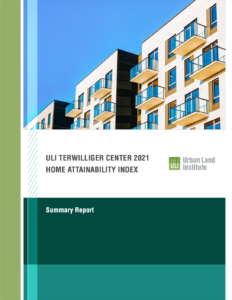Knowledge Finder
The ULI Terwilliger Center’s 2021 Home Attainability Index provides practitioners with an easily accessible resource that can set a data-informed foundation for regional discussions of housing needs and solutions. Specifically, the Index provides a high-level snapshot of the extent to which a housing market provides a range of housing choices attainable to the regional workforce, with an intentional focus on issues related to racial, socioeconomic, and intraregional disparities and inequities.
 The Index is designed to support local municipalities and members of the development community who are working to address longstanding challenges related to home affordability – it includes an interactive spreadsheet enabling users to filter and segment data via various metrics. Over time, the Index will enable national and regional comparisons to inform decisions about housing production, policy, and financing.
The Index is designed to support local municipalities and members of the development community who are working to address longstanding challenges related to home affordability – it includes an interactive spreadsheet enabling users to filter and segment data via various metrics. Over time, the Index will enable national and regional comparisons to inform decisions about housing production, policy, and financing.
Since the release of a pilot edition of the Index in 2020, the center has worked with a national cross-sector group of partners, including the National Housing Conference (NHC) and National Low Income Housing Coalition (NLIHC), to expand and improve the resource. It now has an array of 30 housing and equity-related metrics across five categories, including: overall affordability; homeownership attainability; rental attainability; neighborhood opportunity and access; and housing production. It includes data on the 100 most populous metropolitan statistical areas (MSAs) in the U.S., as well as an additional 12 MSAs served by ULI District Councils.
Patterns of housing insecurity and racial and socioeconomic inequality that existed prior to Covid-19 have been exacerbated by the pandemic and the associated economic downturn. The Home Attainability Index will help to shine a light on where the main issues are, enabling us to find potential solutions to creating a more equitable society.
Michael A. Spotts
Visiting research fellow with the ULI Terwilliger Center for Housing
As part of the suite of Index-related resources the ULI Terwilliger Center released a national summary report, which found that:
- The most severe cost burdens among middle-income households are predominantly found in the most populous regions.
- However, there is a nationwide lack of attainable homes for critical members of the workforce that is not limited to the United States’ most vibrant metropolitan economies;
- In particular, thereis a national struggle for lower-income households to find attainable rental units; and
- Segregation – both by income and race – cuts across market types and geographies, and high housing costs threaten to worsen racial and socioeconomic disparities.
Also included within the Index-related resources is a Housing, Health, and Covid-19 Crisis policy brief, which highlights several policy activities that can support frontline and economically disrupted workers, including:
- Maintaining eviction protections for the duration of the crisis;
- Providing ongoing rental assistance to support very-low-income households;
- Developing policies and funding streams that address the burden of deferred rent and mortgage payments; and
- Providing capital to maintain and preserve the viability of the housing stock that serves lower-income households.